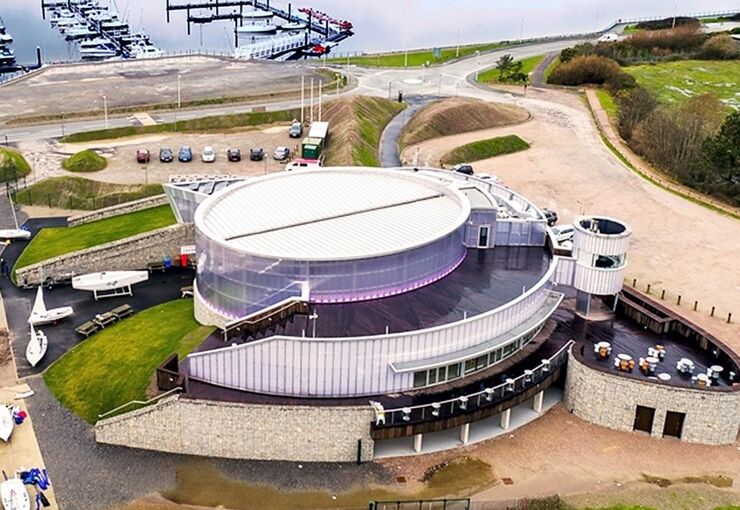
‘Plas Heli’ on the southern coast of the Llyn Peninsula in Gwynedd, north-west Wales is home to the Welsh National Sailing Academy and a major events centre. Following its completion in July 2015, the NEC procured development has already hosted several national and international sailing competitions as well as numerous triathlons and trade shows.
The two-storey circular building includes training facilities, changing rooms, a flexible events space, restaurant, café bar and roof terraces. Supported on pad foundations, the lightweight 1,600 m2 steel-framed structure features concrete floor slabs, local stone wall cladding and translucent Danpalon wall and roof panels to minimise artificial internal lighting. Together with solar panels and a biomass boiler, the building has achieved a Breeam ‘excellent’ environmental rating.
External works comprised access road realignment, carpark reconfiguration, diversion and rerouting of services and extension of the existing marina’s berthing facilities – which included installing an 80 m long quay wall, 12 mooring piles supporting floating pontoons, and a 40 m access bridge.
Gwynedd Council’s commercial consultancy YGC let all the consultancy packages under the NEC3 Professional Service Contract (PSC), including architect Ellis Williams and engineering consultant WYG. The external works were let to contractor Jones Bros Civil Engineering in two phases, with the highway and service diversions let under a six-month NEC3 Engineering and Construction Short Contract (ECSC) in January 2012. The seven-month marine works were let under an NEC3 Engineering and Construction Contract (ECC) Option A (priced contract with activity schedule) in January 2014, after which building works were let to Wynne Construction under an ECC Option B (priced contract with bill of quantities) in July 2014.
Collaboration from the outset
According to NEC project manager Gareth Wright of YGC, ‘The key challenge was to deliver a £13 million vision within an £8.9 million, time-limited funding package. This meant working collaboratively with the project team and stakeholders from the outset to identify the most cost-effective and rapid delivery solutions.
In line with the NEC requirement to work in a ‘spirit of mutual trust and cooperation’, he says the integrated project team embraced collaboration from the beginning, with great emphasis on project risks, value engineering, opportunities, constraints and added-value enhancements. ‘There was excellent co-operation between the different works teams, ensuring they successfully delivered a significant project for the community.’
In addition to holding regular workshops to help refine the design and interface details, the team also provided an integrated approach to meeting user needs and undertook wider community consultations throughout the whole briefing, design and delivery process. ‘Regular sessions were held with key stakeholders to encourage active engagement, to capture lessons learnt and to promote current best practices over each NEC-procured phase,’ says Wright.
Civils, marine and building phases
On the initial highway and service diversion phase, the team’s NEC-inspired collaborative approach and continuous engagement with key stakeholders meant that the work was carried out with minimal disruption to local businesses, current facilities, events and public access.
On the marine works phase, the contractor proposed an innovative solution to the disposal of 83,000 m3 of dredged material, resulting in savings of over £1 million. This involved building a 140 m long containment bund within the marina and reinforcing the seaward side with rock armour. This created a basin where dredge arisings could be pumped ashore and allowed to drain, forming both a land reclamation area and additional space for further maintenance dredging. Value engineering led to further savings of more than £0.25 million.
The building design was also optimised to reduce costs, with use of a lighter steel frame instead of concrete saving money directly and avoiding the need for piled foundations. Additional savings were achieved by replacing the concrete retaining walls for the grassed access ramps with stone gabions and reinforced earth.
‘The building phase was tailored to reflect the sensitivities of working in a live environment, with sailing activities and relocations carefully considered to avoid impact to the provision of a productive working environment for the end user,’ says Wright. ‘The rolling and phased segregation and logistics plans maintained the free-flow of competitors, boats, staff and the public around the site perimeter.’
During construction, on-site weekly ‘planned and complete’ meetings were held to monitor and review progress. This enabled precise coordination and monitoring of progress and performance, and any implemented remedial measures to recover slippage.
Wright says the building contractor also built on existing relationships with local education providers to identify and maximise placement opportunities, specifically targeting 16–18 year olds, women and long-term unemployed. ‘Localised skills development and retention was supported throughout and a community fund was also established to support community groups.’
Benefits of using NEC
- Flexibility of NEC suite enabled the client to let separate consultancy, building, civil and marine contracts using a common procurement approach.
- NEC requirement to work in a ‘spirt of mutual trust and co-operation’ led to a high level of collaboration within the project team, with a strong focus on minimising project risks and adding value.
- NEC processes and procedures engendered a proactive approach to managing change.




